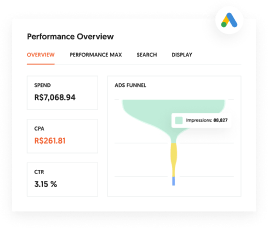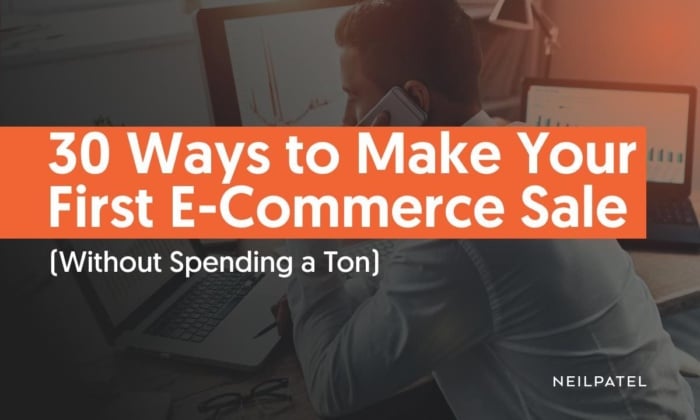
As an online merchant, making your first sale is as symbolic as it is necessary.
It doesn’t sound like much, but believe me when I say the optimism and reassurance it brings can make it the biggest milestone in the life of your business.
Getting that first sale isn’t always easy, though. It can sometimes be a long, arduous battle.
To make the battle easier to win, below are 30 sure-fire tips to get more online sales without spending a ton.
Let’s dig into how to make your first sale online.
1. Send Free Samples to Influencers
You don’t need to look far to find influential bloggers, journalists, entrepreneurs, and vloggers from various industries and niches. You just need to find the right ones.
Searching social media platforms for influencers and building relationships with them is one way to get started. Using influencer “matchmaker” services like TRIBE is another.
Sending a free sample of your product to influencers who are active in your industry or related to it in some way gives you an opportunity to let them know you appreciate their work with a small gift. Hopefully, you will get a mention on one of their sites or platforms.
This can result in a spike in traffic and social media followers, but you’ll also have a seal of approval from industry experts. And that can make all the difference when you’re looking for your first sale. If you want to learn more about engaging influencers then read my definitive guide to influencer targeting, which tells you everything you need to know about getting your brand under relevant, important noses.
2. Reduce the Number of Product Choices
Decision fatigue is a thing. Too many choices, too much analysis required, and less purchases are made. (Yes, in that order.)
So, how to make your first online sale? Reduce the number of products you sell. Here are four ways you can achieve this:
- Prioritize your best-selling products. Funnel visitors to your best-performing products. Similar to how you’d ‘funnel’ visitors to your best-converting pages or blog posts when trying to increase conversions.
- Group your products in order to not overwhelm people. That might apply to category (or even subcategory pages). If possible, one page, one goal. Helix is one of my favorite examples. Their Shop page condenses multiple mattresses down into a ‘single’ product.
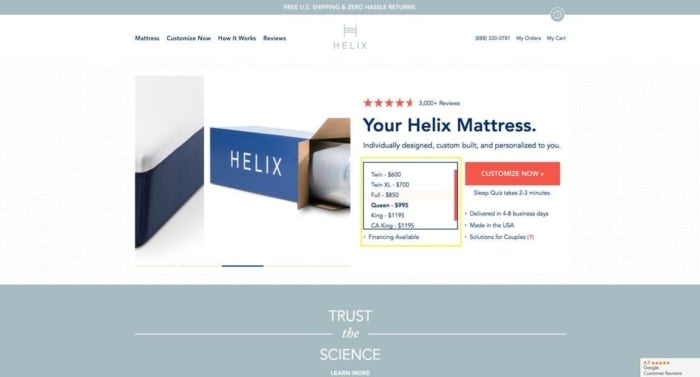
Then from there, you go into a customization builder to select, add, or remove different attributes. The result is a simplified, streamlined, approach. You only have one or two decisions to make on each section at a time.
- Segment your traffic to tailor what customers see. Show users what they’d be most interested in. Based on previous visits or purchases. That’s what Amazon does right on their homepage:
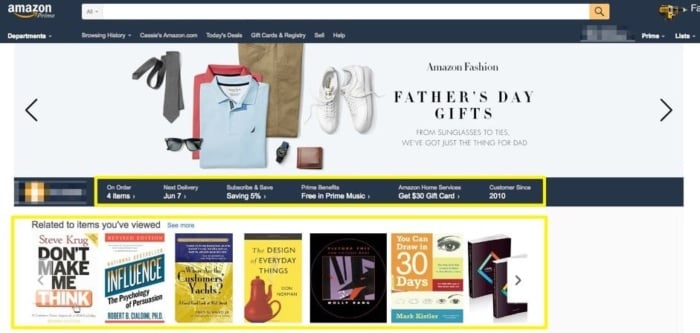
3. Visually Streamline How People Choose Products
Just because you have three digits worth of products sitting on shelves somewhere (undoubtedly collecting dust) doesn’t mean you have to haphazardly force all those things onto the same page.
Instead, group your products to avoid overwhelming people. That might apply to category (or even subcategory pages). If possible, you want to keep it to one page, one goal.
That can even apply to the entire conversion funnel on your site.
Helix is one of my favorite examples. It sells mattresses. Not exactly unique or different. Boring, right? So, what’s so special about Helix? Well, for one, its clean website design makes choosing the right mattress a breeze.
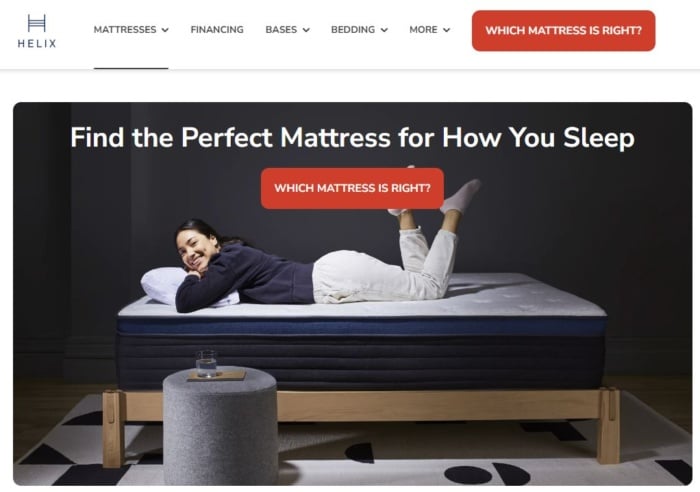
It condenses multiple mattresses into different categories and price points to narrow your choice.
From there, you can click on Core Collection, which takes you to another list of choices like “side sleeper” or “medium feel.” This narrows down your choices considerably (and quickly).
The result: a simplified, streamlined experience.
4. Prioritize Product Presentation
Sometimes you can’t (or don’t want to) eliminate products from a page. So reducing the number of choices is out.
But you can still use a few tricks in order to prioritize products. That would give people a visual hierarchy of what’s most important through a series of images, shapes, text, etc.
Start by using size to prioritize products. Here’s a good example from the Dollar Shave Club:
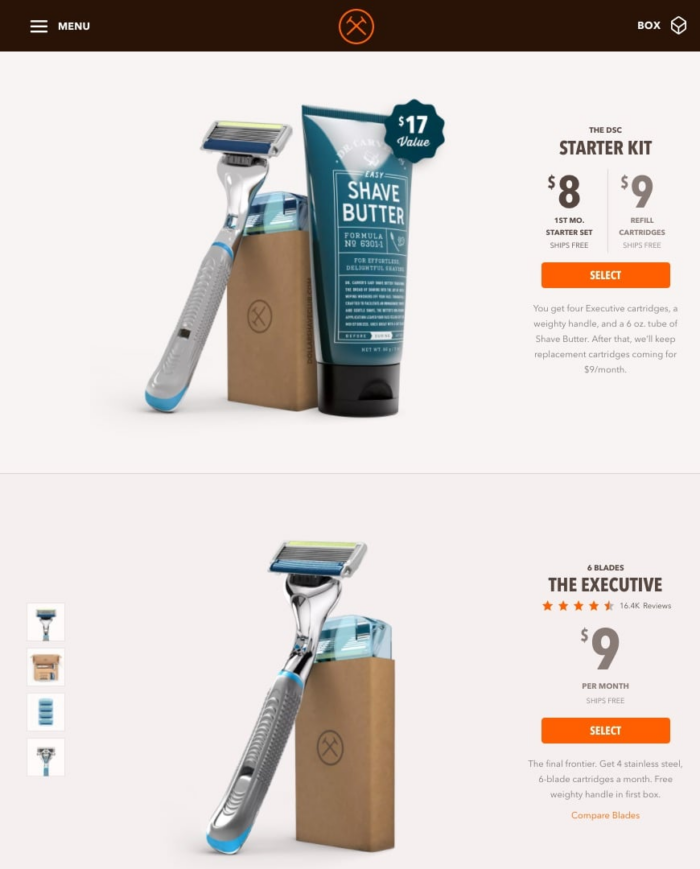
First, they’ve reduced the number of options. That much is true. But then they also have used product sizing to help you prioritize which one to go with.
Next use videos or gifs to catch your customers’ eyes. Check out this Bonobos example to see how motion catches your eye:

Or try using contrasting colors. For example, the first image of the three below has the least amount of reviews. But it catches your eye because of the different background image.
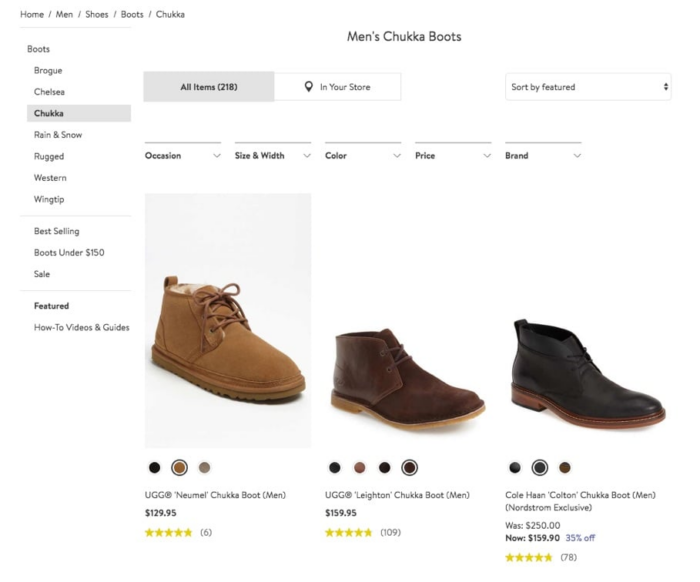
5. Offer a Promotion or Discount
Consumers love to feel as if they’re getting value, which is why this approach works well. When you offer a promotion or discount, you give prospects the ideal incentive to sign up for your email list.
If your lead is browsing, a pop-up box offering a small discount can be enough to get them part with their email details. From there, you can nurture your subscriber through the customer journey, sending them promotions and educational materials based on their search data.
In fact, one company used a simple discount pop-up to generate more than 600,000 views and more than 40,000 email sign-ups.
6. Start Blogging
If you aren’t already running a blog associated with your store or product, then you’re missing out on the limitless potential of content marketing.
By producing free, valuable content, you create trust in your brand and keep people informed. Blogging also gives you scope to share on social media and helps you rank in search engines.
To get started, consider starting-point queries people have about your products and industry. Then, use your blog to answer these questions as individual articles. My tools AnswerThePublic and Ubersuggest can help you come up with ideas.
For example, visitors to the Shopify blog might be interested in learning about e-commerce and drop shipping. To meet that need, Shopify might create content that ranks for terms like “how to sell online” and “how to drop ship.”
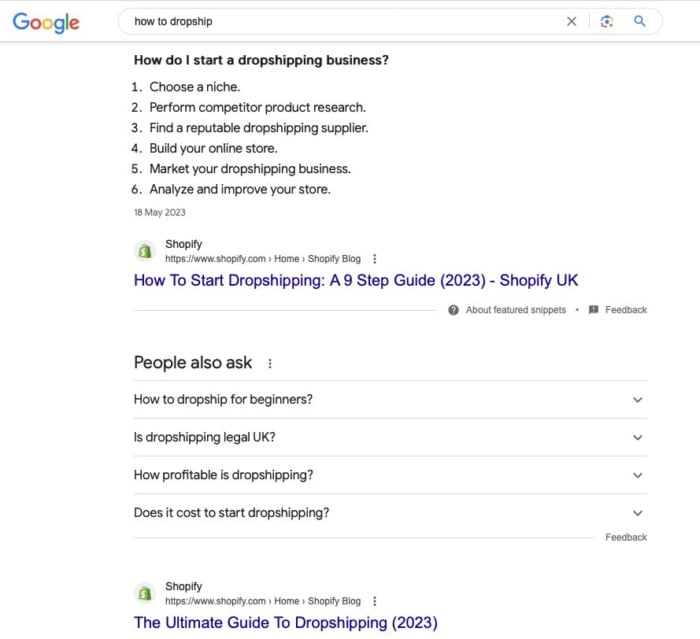
Additionally, you can use your blog to offer tips, tutorials, and resources related to your products and the lifestyle around your products.
If you can create epic content on a regular basis, you’ll begin to see the power of content marketing via social media shares, search engines, and so forth. All of this is covered in my guide to content marketing.
7. Build an Email List
Building up an email list is absolutely essential if you want customers to make repeat purchases—and it can help you to make your first sales, too. Best of all, it doesn’t have to cost you a thing.
According to Litmus, email has an average ROI of $36 per $1 spent—not too shabby. Building your email list doesn’t cost much, either.
Having a list of emails from previous and potential customers means you can get your information, products, and content into their inboxes. In contrast, updates made to your Facebook page and Twitter handle will almost never reach your entire following, due to time zone differences and social media algorithms.
Start building your email list by including an email subscription form on your website.
Here’s a clever way to convince visitors to sign up for your list. Instead of simply saying “Join our Newsletter,” offer an incentive or some type of value for signing up. Skinny Teatox offers the chance to win a free product every week, so they showcase that offering to encourage people to join.
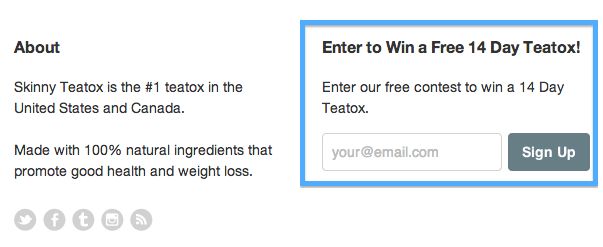
If you need some more advice on how to get started, read my beginner’s guide to email marketing.
8. Sponsor an (In-Person or Virtual) Event
Sponsoring an event can work wonders for your online sales—if you use the right approach.
First, ensure you select the right event to sponsor. Search for events where attendees are likely to be interested in your product, and then find out how many consumers will be in attendance.
Then start sorting them by cost.
Avoid sending a convoy of marketers to set up a table and hand out flyers. If there are potential customers attending, you’ll need to be more creative to build relationships.
Demonstrate some of your most interesting products to tell your story, get people talking, and provide on-the-spot rewards like coupons and free stickers in return for email list subscriptions and social media follows.
Here’s how I recommend you measure the ROI of these kinds of events.
9. Interview Industry Influencers
Remember how I mentioned the importance of content marketing earlier? Well, interviewing an industry influencer is an excellent way to create epic content.
Interviews work because they are win-win situations. The interviewee gets more exposure, while the interviewer gets their hands on some hot content for their publication or blog.
Make the most of these interviews by asking relevant questions about their lives and careers and the industry as a whole. This gives fans of the influencers get a taste of their personalities, while others will value their expert advice.
Here’s an example from Eric Siu, author of Leveling Up, who recently interviewed my business partner Hiten Shah.
10. Pull a PR Stunt
If you want that first sale fast, pulling a PR stunt could do the trick.
Much like viral videos, a PR stunt has the potential to propel your brand into fame. If executed well, you’ll be swapping conventional time-consuming brand marketing with instant publicity, gaining loyal followers and customers in the process.
A PR stunt involves doing something unusual, outrageous, hilarious—basically something remarkable enough to be worthy of media attention.
As a result, your store could benefit from tons of links from authoritative news sources, which is great for both traffic in the short term and SEO in the long term.
No company pulls a better PR stunt than Virgin. Their founder, Richard Branson, has dressed up as a wedding bride, jumped off a casino roof, posed as a Zulu warrior, driven a tank down Fifth Avenue in NYC, and flown a balloon around the world, among many other newsworthy things.
Stunt videos, flash mobs, themed events, and guerilla marketing are just some ideas you could use. However, if you’d like some tamer suggestions, you could consider charity events or creating giant replicas of your product to capture attention.
There’s been plenty of examples from the past year to get your creative juices flowing. Take Penguin, for example, who created an unburnable version of The Handmaid’s Tale in response to book bans. Or Airbnb, which partnered with nonprofits and governments to secure housing for 100,000 refugees. Is there some way you can alter your product to strike a chord with current events?
11. Experiment With Google Ads
Google Ads (formerly AdWords) is Google’s hugely popular pay-per-click advertising network that allows online retailers to place advertisements on nearly every Google search results page, YouTube video, and partner website.
Who wouldn’t want to rank in the top three of a search query that drives sales? Here’s what shows up when you type “Converse” into Google. Note that the first Google Shopping results are paid ads from Converse.
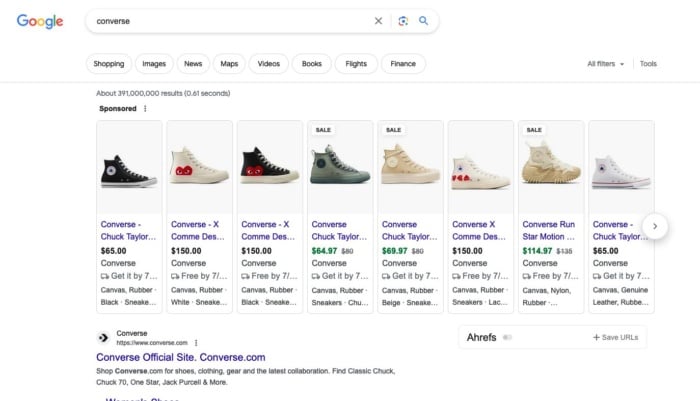
The beauty of Google Ads lies in its speed and massive reach. In just a few minutes, you can set up and launch an advertising campaign that gets your text, image, or even video ads seen by browsers all over the web.
With Google Ads, you can create targeted campaigns that show up in Google searches when users look for specific keywords. Your ads can also appear on websites and alongside articles that use similar keywords, getting your ads in front of your target audience.
Setting up a Google Ads account is easy! Just follow these simple steps:
- Go to the Google Ads website and click on Start Now.
- Choose the goal you want to achieve with your ads, such as increasing website traffic, generating leads or sales, or promoting your app.
- Set your budget and bidding strategy. You can choose from several bidding strategies, like manual bidding or automated bidding.
- Create your first ad campaign. Consider the keywords your target audience might use to find your product or service and create targeted ads that appeal to them.
- Launch your campaign and monitor its performance using the data provided by Google Ads.
Make adjustments as needed to optimize your campaign’s performance. For more info, check out my Google Ads step-by-step guide.
12. Segment Your Audience
Want to increase your chances of conversion? Then use personalization.
Why? Simply because you don’t want to offer the same products to everyone visiting your store. Instead, segment your traffic and show visitors the items they’re more likely to buy.
All you need is the data from your customers’ previous searches, and you can display items they’ve already shown a keen interest in.
It’s an approach that works for Amazon. If you search for a product on Amazon or buy something, the first thing you’ll see on its homepage are messages such as:
- You might also like
- Often repurchased
- Buy again
- Keep shopping for
- Selected for
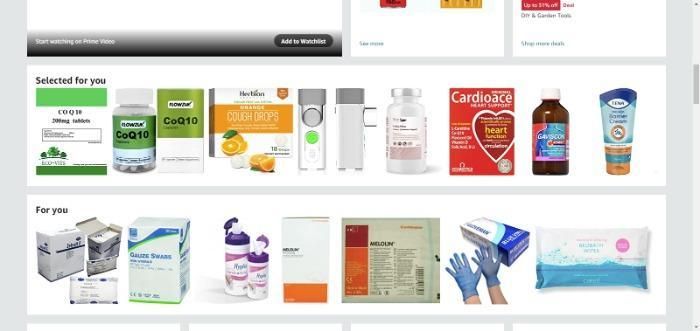
As a dominating force in e-commerce, Amazon knows what it’s doing. There’s no reason you can’t do it too.
You can also personalize in other ways, such as by:
- Focusing on different segments of the market (i.e., financial, marketing, project management sectors, etc.).
- Targeting by behavior, location, referring URL, ad content, device, search keywords, and customer history.
- Looking at session behavior, like date and even time of day.
If you can’t personalize pages like this, perhaps try inbound funnel segmentation. Line up the specific product pages with the source, medium, or channel someone’s coming from.
13. Share the Load With Affiliate Marketing
Trying to sell your products alone can be difficult, so why not share the load with others?
Affiliate marketing is when you partner with other brands to market your products in their content. In return, you pay them a percentage of any sales that originate from their promotions. You can track their marketing efforts by providing a unique hyperlink or coupon code.
For example, a website owner may post your affiliate link for a blue sweater for sale on your website. If one of his website visitors clicks the link and then buys the blue sweater, you’ll have made a sale, and as an affiliate, the website owner gets a percentage.
Affiliate marketing’s success depends heavily on the types of products you sell and the commission percentage you reward affiliate partners.
To get started, check out my explanatory affiliate marketing guide, which goes into great detail about the different strategies and methods you’ll need to know.
14. Sell Wholesale to Other Retailers
Selling to consumers is fine, but selling wholesale might be just what you need to get the sales going.
One of the main advantages of selling wholesale is the obvious increase in cash flow. A lower profit margin might exist, but quantity can make up for the difference.
Additionally, you enable other companies and resellers to market for you, spreading the word about your merchandise as they buy it themselves. This means selling wholesale could indirectly boost your consumer sales.
For a crash course on the basics of selling wholesale, check out Shopify’s guide to running a wholesale business.
15. Publish a Press Release
You’ve issued a press release, and you’re expecting a queue of journalist inquiries and a ton of visitors. Instead, you get little in the way of traction, and you wonder why you bothered.
Getting ignored by every news outlet when distributing a new press release is demoralizing and often a huge waste of resources.
The secret to getting noticed is simple. Don’t publish a lousy press release, and ensure it’s newsworthy.
Here are some tips for writing a press release:
- Have a clear and attention-grabbing headline summarizing the news, and use subheadings for clarity.
- Start with a strong lead paragraph that summarizes the news concisely. It should answer the five W’s (who, what, when, where, and why).
- Give more information in the body of the release. Make it concise and use quotes from relevant parties if possible.
- Include relevant facts and figures to support your news.
- End with a short, strong concluding paragraph that reinforces the message and includes a call to action.
- Add contact information for further inquiries and relevant social media handles.
- Provide clear images.
To distribute your press release:
- Research the media outlets relevant to your industry or niche. You can use tools like Muck Rack or HARO to find journalists who cover your topic.
- Personalize your pitch and outreach emails, and include relevant contextual information. Ensure you offer a value proposition for why the journalist or outlet would want to cover your news.
- Consider offering exclusives or early access to some outlets to increase your chance of coverage.
- Use a distribution service like PRLog or Pressat to reach a wider audience and increase your chances of relevant news wires and outlets picking up your release.
- Share your release on social media and consider boosting its reach with a small paid promotion budget.
- Vary your release depending on where you’re distributing it. For instance, if it’s a local newspaper, base it on your local business starting up. If you’re contacting a national publication, use a broader, more topical angle.
- Monitor the coverage and follow up with journalists and bloggers who covered your news. Building a relationship with them can increase your chances of getting coverage in the future.
Not sure where to start with drafting your release? Download templates from HubSpot.
16. Pay Attention to Site Analytics
The behavior of every website visitor from entry to exit helps you understand why you are selling and, more importantly, why you aren’t.
Your website stats (or analytics) will show you what your customers are doing on your site, including which web pages they enter, the time they spend on particular pages, and the route they take to leave your site. Occasionally, some tools display additional information—for instance, how frequently a customer visits your site.
It won’t cost you a penny, either. Google Analytics is a free service allowing you to measure your traffic in more ways than you can imagine.
Here’s an example of Google Analytics in action from White Chalk Road.
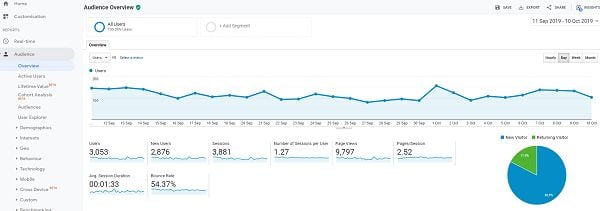
You can measure who visits your website, where they come from, and how users interact with it.
While you’re fighting for your first sale, it’s extremely important to spend time analyzing your traffic in Google Analytics. You never know what you’ll learn.
If you need a hand getting started, read my article on how to navigate Google Analytics like a pro. If you haven’t migrated to GA4 yet, then read my guide on doing so, too.
17. Run a Survey
Consumer surveys are an ideal tool for obtaining honest feedback. Unlike your friends and family, consumers have no qualms about hurting your feelings by picking at your web design or your marketing material.
To run your very own survey, you can make use of online apps like Survey Monkey and Qualaroo to create online surveys.
QuestionPro has a list of 45+ questions to ask e-commerce visitors, which can help you get the most out of your feedback.
18. Network on Social Media Groups or Forums
Online discussion forums and social media groups are great places to share industry tips and advice, answer questions, and acquire customers.
Use Google or Facebook to find active forums and groups directly related to your niche. Twitter chats and Discord are also venues for niche discussion groups.
When you post, ensure you aren’t breaking any rules by promoting your brand or products. Get to know the forums’ restrictions and stick to them. Using your forum avatar, signature, and profile page to promote your brand is usually well within the rules.
No group will tolerate constant promotion or posts with links to your website. Besides, it makes you look spammy. Keep it simple by posting just enough for people to notice your activity but not enough to constitute spam.
Two popular business-focused forums worth getting active on are Digital Point and Warrior Forum, which have thriving, helpful communities.
19. Build the Right Relationships
It’s not what you know. It’s who you know. So building the right online and offline relationships can be your portal to success.
No matter what type of product you sell or which industry you work within, there are like-minded businesses out there you need to befriend.
The trick is building relationships with others closely aligned with your business rather than direct competitors.
For example, suppliers, blogs, and websites focusing on your industry are ideal. They can help provide you with consumer feedback and offer promotional deals without stepping on your digital toes.
Take The Ecommerce Group, for example. Operating via a Facebook group, they have over 8,500 members sharing advice, giving feedback, and providing a helping hand whenever possible.
20. Offer a Contest or Giveaway
Everybody loves free stuff, and if you’re looking to build up some trust while kick-starting your online sales efforts, a contest or giveaway could help you do just that.
Not only can contests and giveaways help you build valuable inbound links, but they’re also a great way to show potential customers they can trust you and that your brand means business.
Tease Tea ran a simple contest on their Facebook page.
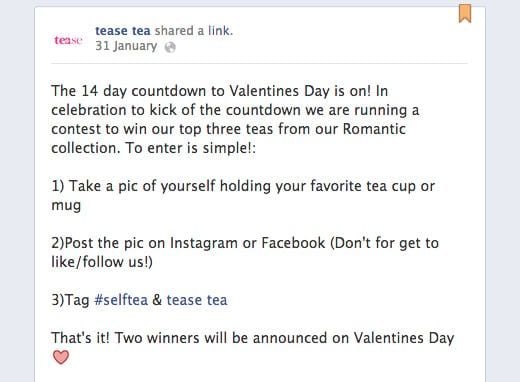
This contest costs no money to run and likely took only a few minutes to put together.
The pizzeria also used its post to get inspiration from Facebook users. That’s a great idea if you’re feeling stuck and want audience input. And, of course, it’s an engagement goldmine.
Online services like ViralSweep and Gleam enable you to run such contests and giveaways online, helping you to keep things simple and professional without all the added work.
21. Begin Tweeting
Twitter’s simplicity makes it one of the most effective ways to engage with your target market. An excellent method for finding potential customers is proactively searching for people tweeting questions about your industry and reaching out to them.
The idea is not to pitch or mention your products, just to be helpful. Let’s say you sell sneakers. If you see someone asking questions about which type is best for ankle stability or arch support, respond to them.
You don’t need to link to your store. However, you want to include your URL on your Twitter profile so users can click through.
This was the strategy used by Neil Jhaveri when building Mimestream, a native MacOS client for Gmail.
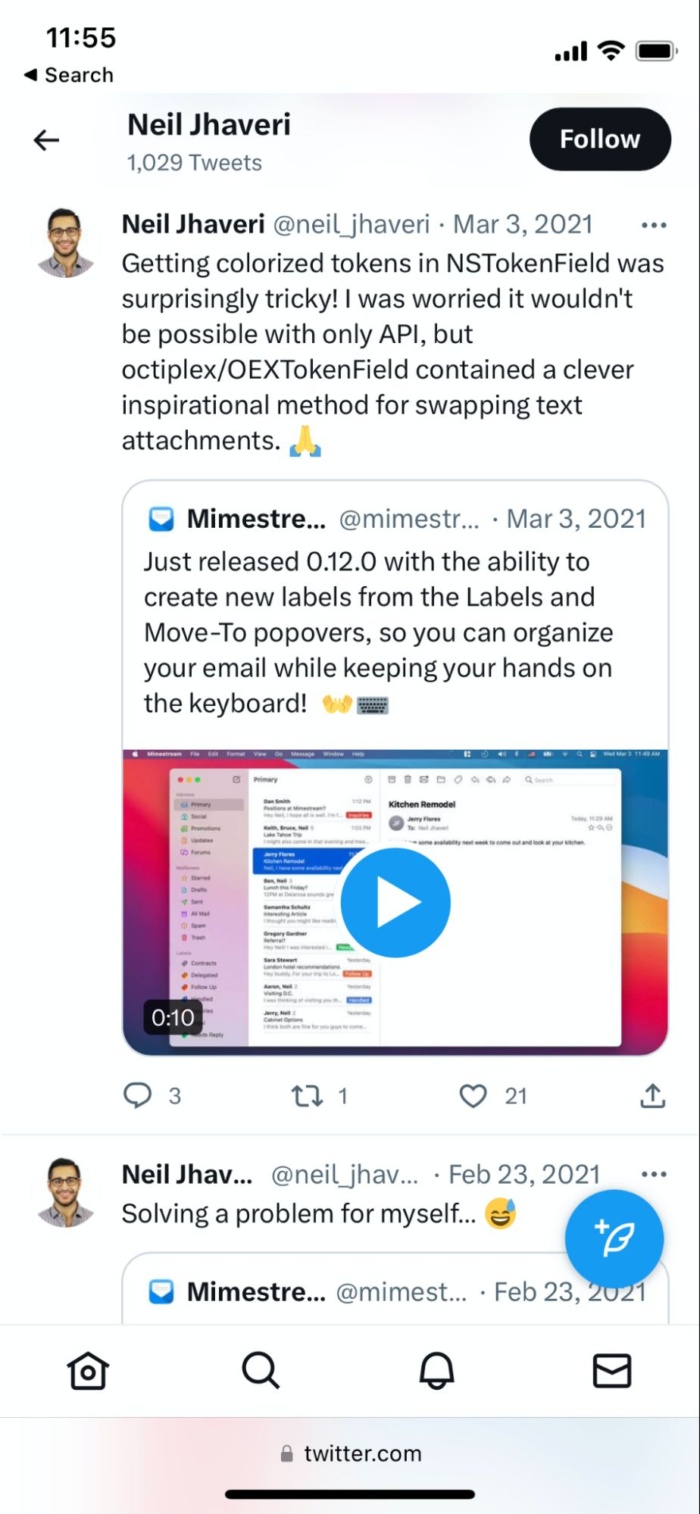
Neil created hundreds of tweets about how he was coding his app and the problems he faced. He also asked his audience for their opinion. His strategy worked wonders; he acquired over 160,000 beta users over a two-year period.
22. Make Connections on LinkedIn
LinkedIn is the office block of the internet. You’ll find professionals and executives of all types boasting about their abilities and connecting with others.
Set up your e-commerce business profile and you can do the same. You may not make any direct sales through LinkedIn, but you’ll discover an array of opportunities with other companies, suppliers, and related websites.
LinkedIn Groups also are a stellar way to engage with other business owners in your industry. Many public and private groups are available for specific niches, allowing you to post questions and converse with other members.
To find relevant Groups, search on LinkedIn or ask your followers what groups they recommend.
23. Go Visual With Pinterest, Instagram, or TikTok
Pinterest, Instagram, and TikTok are all excellent platforms for engaging potential customers visually. Whether you prefer videos or photos, using visuals allows your prospects to absorb information easier. Additionally, they help bring your products to life and inform the buying decision.
These platforms are the perfect place to present the creativity and passion that goes into your business behind the scenes. Snap pictures of your products, take manufacturing process videos, tell a story with images, provide demonstrations and introduce your staff.
These social media channels also complement your e-commerce sales efforts, attracting new customers and driving traffic to your store while enhancing brand awareness.
Here are some tips for getting the most out of each platform:
Instagram:
- Use high-quality images and follow resolution guidelines.
- Optimize your images for Instagram’s algorithm using hashtags in captions.
- Keep your product images consistent with your branding to create a cohesive visual aesthetic.
- Use Instagram stories to show a more behind-the-scenes look at your brand and showcase your products in day-to-day use.
Pinterest:
- Optimize your pins using keyword-rich descriptions for your images.
- Design highly pinnable graphics that showcase your products or services with eye-catching visuals.
- Use Rich Pins. These provide metadata and give additional details about your products.
- Take advantage of seasonality and trends by creating boards specific to the holiday, season, or event. Highlight your products and give links back to your store.
TikTok:
- Use trending music and hashtags to help your posts reach a wider audience.
- Add video editing features such as filters, effects, and transitions to make your content more engaging and visually interesting.
- Personalize content for your audience by considering region, language, and cultural variations.
- Keep up with the trends and always create new types of content to keep your audiences engaged.
Need some visual inspiration? Melt Cosmetics started as a new brand but now has 3 million followers on Instagram.

They are doing a great job of Instagram marketing, building a brand image and a following with their beautiful photographs.
24. Don’t Forget Facebook
OK, so maybe Facebook isn’t as popular as it once was. However, with nearly 3 billion monthly active users, it’s still well worthwhile.
Begin by leveraging your personal Facebook profile and your business page to engage with friends, family, and acquaintances and get people talking about your products. Then, get creative with status updates and interact on public groups and fan pages relevant to your niche. For instance, a popular blow-drying salon in Toronto called Drybar has an extremely engaged Facebook community of over 200,000 who talk all things blow-drying.
If you’re fresh out of ideas for your Facebook business page, check out my ultimate guide to social media e-commerce.
25. Beat the Competition on Comparison Shopping Engines
Most consumers like to shop around before making a purchase. This includes visits to search engines and sites like Amazon.
Popular engines include Google Shopping, PriceGrabber, Amazon, and a range of others, all simultaneously comparing thousands of products and stores.
There are many advantages to using price comparison, including:
- Increased visibility: By listing your products on price comparison sites, you increase their visibility to potential customers who might not have found them otherwise.
- Potential for increased online sales: Customers who use price comparison sites are often looking for the best deal, and if your store offers competitive prices, you can attract these customers and convert them into buyers.
- Increased trust: Listing your products on reputable price comparison sites can help build trust with customers who might otherwise be wary of shopping with an unknown online store.
- Cost-effective advertising: Price comparison sites like Google Shopping offer free listings or low-cost advertising options, making them a cost-effective way to drive traffic to your e-commerce store.
Here’s an example from where I’m searching for a price comparison on my favorite hot sauce:
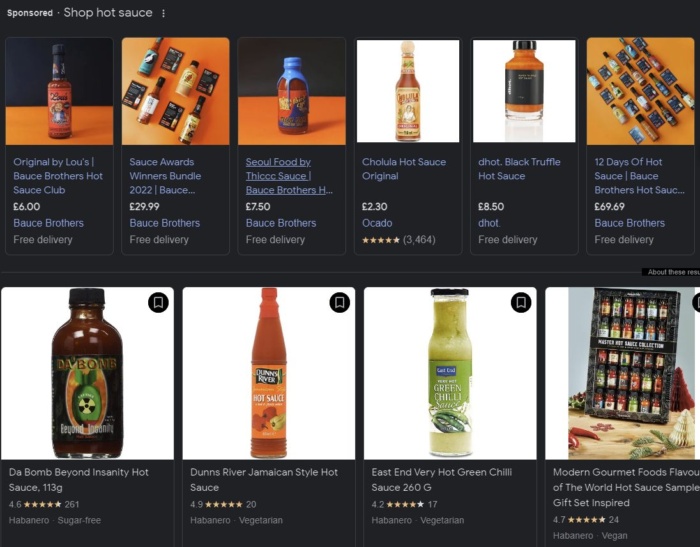
To get noticed, you need to play by the rules of each engine, stay competitive in terms of price, and play the waiting game while experimenting to find out which engine suits you and gives you the best ROI.
Shopify has a list of the 30 most popular comparison shopping engines with brief explanations of each one and how to use them to drive traffic.
26. Create an Infographic
An infographic is exactly what the name implies, a graph of information—and they are really easy to create these days using tools like Canva, PowerPoint, and Word.
Infographics are gold when it comes to social shares and search engine traffic. According to Venngage, 36.4% of marketers used original graphics like infographics in 2021. And for good reason. They can easily double your traffic.
These infographics impact your online sales in other ways, like:
- Increased engagement: Infographics are eye-catching and can grab attention quickly, making them more likely to get social shares, and they work well. According to research by HubSpot, 56 percent of marketers say infographics are their most effective type of content.
- Improved comprehension: Complex information can be difficult to understand when presented in text alone. However, infographics provide visual aids like charts, graphs, and images to make information more digestible. People often prefer visual learning, and some retain and understand information better this way.
- Increased traffic: When an infographic gets social media shares, it can drive traffic back to your website. According to figures online, infographics get three times more shares and likes on social media. This can increase your brand’s visibility and recognition.
- Better SEO: Infographics can also help improve your search engine ranking by increasing website backlinks when others share them online.
In fact, according to Pixel Productions, which has created an inspiring and detailed guide to marketing with infographics, they can boost web traffic by up to 12 percent.
27. Design Your Store to Look the Part
First impressions count, especially regarding your website design. I’m talking about more than mere aesthetics here. Of course, your website should look good. However, it must also provide a good user experience (UX).
Not a designer? That doesn’t matter! Begin with the basics. Look at the store from a visitor’s perspective. What would make the store easy to use? Consider simplifying navigation, having lots of white space, and avoiding clutter.
Making your store mobile responsive is also crucial. More than half of all internet traffic comes from mobile devices, so make sure your site works and looks good on phones and tablets.
If you are using WordPress, look for themes that are specifically designed for e-commerce.
To get some creative ideas about your own store’s design, have a look at my guide on designing an e-commerce store that converts.
28. Host a Pop-Up Store
Just because your store began on the internet doesn’t mean you have to stick purely to online marketing. An e-commerce pop-up store could be just what you need to complement your website.
Unlike traditional brick-and-mortar premises, a pop-up store is temporary and costs much less. However, it’s vital to remember that location is everything.
You can open a pop-up store at farmers’ markets, art fairs, shopping malls, galleries, and any other bustling area. Just ensure you’re set up in a clearly visible area where your target market will likely wander.
In addition, a pop-up store can act as a great offline marketing outpost. You can use your store to hand out coupons for your online store, give out business cards, invite people to sign up for your newsletter, and encourage more social media followers.
29. Document Your Launch on Reddit
Reddit is a socially powered news and entertainment website where users submit content. More importantly, Reddit is a place where you can attract a large number of dedicated followers and customers.
Using the r/entrepreneur subreddit, in particular, you can introduce your brand, gain consumer feedback, learn lessons, and promote your products.
The process has to be one of give and take, though. Walk those entrepreneurial Redditors through your journey, take them behind the scenes, detail your mistakes, and expose some personality to gain customers and fans, too.
A brilliant example of using Reddit to promote an online store is what the guys at Beardbrand did. The beard grooming specialists documented their launch on the r/entrepreneur subreddit, getting valuable advice from subscribers and customers while giving back to them via regular updates and inside information.
Reddit can be a potent tool, but it can also be fickle. Take time to understand the community before diving in, follow business promotion guidelines, and don’t take the hard sales approach.
30. Communicate the Product’s Value Proposition
Last but certainly not least, a clear value prop can make all the difference in making your first e-commerce sale.
Why is your product worth buying? What are its benefits? How will it help the buyer? Your answer to those questions should be the ‘end result’ that will ultimately make someone’s life better.
Your value proposition should “boil down” your sales pitch (and all the complexities associated with it) into something the buyer can easily understand and remember, grab their attention and eventually say, “Yes, that’s the one for me.” Because “if you’re the best in at least one way, you’re the best option for the people who value that aspect.”
Cases in point: Apple, not the largest selection of products; QVC, not necessarily prestigious; Tiffany, definitely not the cheapest. But people still buy from them.
Make sure your value prop is incredibly simple; requiring less than a few seconds of thought.
That means no big words. No run-on sentences. No generic garbage. No “collaboration,” or “effectiveness,” or other synergies.
If you’re still struggling, visuals can help add context. For e-commerce, think about showing the product in action.
Short videos also work well, as evidenced by Dollar Shave Club’s infamous viral one they still use front-and-center today.
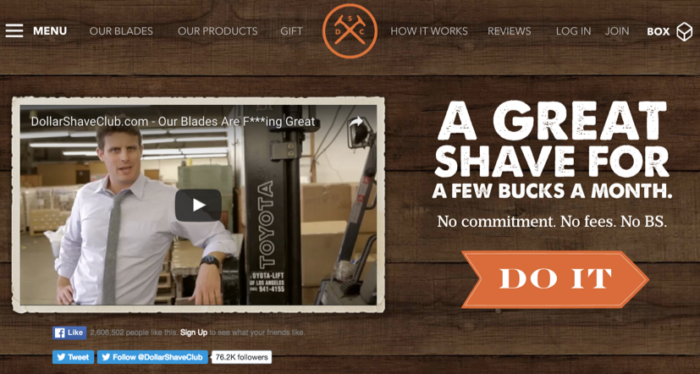
Frequently Asked Questions
Assuming you’ve researched your products and identified an audience, your next step is finding an e-commerce host and setting up a functional website to sell your product. This will be your online storefront, where customers learn more about your product and (hopefully) make a purchase.
Next, create compelling product descriptions that entice your customers. Here, you want to think about the benefits of your product. What problem does it solve for your customers? Take the time to create product descriptions focusing on the benefits, not just the features.
Now, test your site for any tech issues and complete a few test sales to ensure all areas work smoothly.
Finally, it’s time to start driving traffic through social media and SEO. If you’re thinking of increasing your online sales fast, consider paid advertising. Keep testing your promotional methods to see which works best for you.
Focus on getting your first few sales and use those to gain momentum. Ask for reviews and testimonials from your first customers and maybe offer a small discount if they introduce other customers.
Also. optimize your website for conversions. This means creating clear, compelling calls to action and minimizing distractions that might detract from the purchasing process.
You could also try retargeting ads to reach customers who have already shown an interest in your product.
Another effective strategy is to personalize your marketing messages. Use data about your customers’ preferences and behavior to create targeted campaigns that speak directly to their needs and interests.
There are several potential reasons for this. Your first step should be to check for indexing or tech issues that could impact your visibility.
If this doesn’t help, it’s time to revisit your marketing strategy and keyword usage. Have you optimized your website to reach your ideal customers? Are you blogging and building a mailing list? Are you visible on social media?
Then look at more specific reasons. If you’re getting visitors but have poor sales, perhaps your website design needs some work and navigation needs improving. Test different layouts to see if this helps.
Also, look at pricing to ensure it’s competitive, offer more shipping services in case that’s an issue, and include a strong call to action.
Finally, ask friends or family to test the site and see if they encounter any difficulties during checkout.
Conclusion
Setting up your e-commerce store is no easy task, but now you know how to make your first sale online. The 30 strategies listed above are stellar ways to kick-start sales for your e-commerce store and start your business off strong.
You don’t need to use all of the ideas in this article. If you do, you’re likely to experience overwhelm.
Select various methods that give you a good mix for your online sales strategy and have an analytics system in place so you can see what is working.
Try, test, and keep going until you increase sales and attract repeat customers.
Which strategy will you use to make your first online sales?

See How My Agency Can Drive More Traffic to Your Website
- SEO - unlock more SEO traffic. See real results.
- Content Marketing - our team creates epic content that will get shared, get links, and attract traffic.
- Paid Media - effective paid strategies with clear ROI.
Are You Using Google Ads? Try Our FREE Ads Grader!
Stop wasting money and unlock the hidden potential of your advertising.
- Discover the power of intentional advertising.
- Reach your ideal target audience.
- Maximize ad spend efficiency.

